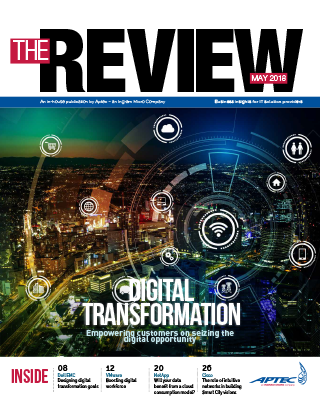 Built for digital business and Internet of Things, intuitive networks promise to transform public sector organizations struggling with legacy networks and looking for a stepping stone towards a much bigger picture, says Shadi Salama, Channel Leader, East Region, Cisco Middle East.
Built for digital business and Internet of Things, intuitive networks promise to transform public sector organizations struggling with legacy networks and looking for a stepping stone towards a much bigger picture, says Shadi Salama, Channel Leader, East Region, Cisco Middle East.
By 2030 the number of connected devices and objects will reach an estimated 500 billion. This rapid growth in networks and devices has meant that the connected world is now too big and too complex for humans to administer effectively. Networks of tomorrow will therefore not be manually administered. They will be too complex, too cumbersome, and too complicated, to effectively allow manual administration. Traditional networking models simply do not scale and perform to meet the expectations of this digital era.
Businesses now need a new networking framework, that is simplified and more secure to use. IDC indicates that businesses that have invested in modern networks, have improved their rate of growth in revenue, customer retention and profit, by a factor of two to three times. For digital organizations, the network is the foundation of their business and success.
From the field of analytics, machine learning can be used to build complex models and algorithms within networks that are capable of generating forward looking trends. Analytical models inbuilt inside networks can produce reliable and repeatable decisions and can uncover hidden insights through learning from historical relationships embedded in data. Machine learning can give networks the ability to learn without being programmed. This approach has evolved from pattern recognition and learning theory in artificial intelligence.
Networks with such in-built algorithms can learn and make predictions from data. With the help of these algorithms, networks can overcome the limitation of static programming and can make data-driven predictions and decisions, through building a model from data inputs. In the past, data mining has been used to discover new trends in wide arrays of collected data. However, in the case of such intuitive networks built on machine learning, algorithms discover known trends that are prevalent in data as it is aggregated.
Networks with in-built machine learning and complex algorithms can establish a pattern of baseline behavior and can successfully flag deviations without supervision. One of the immediate benefits is the ability to successfully build models of optimal network behavior and proactively react without intervention to anomalies and intrusions within.
Intuitive networks shift from the traditional manual, time-intensive, static mode of operation, towards one that is capable of continuously learning from the data that it manages for an organization. The more volume of data it manages, the more it is capable of learning through analytics and adapting for automatic and efficient response.
The intuitive network automates the edge of the network and embeds machine learning and analytics at a foundational level. Both of these characteristics make them well suited for Smart City use case applications.
Dubai recently announced its entry into the adoption of latest digital technologies through its Smart Dubai vision. The vision encompasses advanced technologies like intuitive networks, machine learning, artificial intelligence, and analytics to solve real life chronic problems, achieving sustainable development, maintain
economic competitiveness, as well as providing high levels of quality of life for its inhabitants.
With Dubai’s citizens experiencing some of the highest technology adoption rates in the region, matching their expectations on living, personal development and their quality of life, requires the city to adopt the latest digital technologies as well.
A key aspect of meeting these objectives is to have better digital integration amongst significant citizen facing players inside the Emirate. The Smart Dubai initiative therefore looks at strategic partnerships between 11 government entities operating within Dubai and this includes the Roads and Transport Authority, Dubai Electricity and Water Authority, Dubai Executive Council, Department of Tourism and Commerce Marketing, Dubai Police, Dubai Health Authority, Dubai Municipality, Dubai Smart Government, Department of Economic Development, Dubai Silicon Oasis Authority and Dubai Design District.
These eleven strategic partners are expected to drive use case initiatives using a number of enabling digital transformation technologies. These include IoT sensory systems, advanced analytics, artificial intelligence, 3D printing, drones, wearable devices, robotics, driverless vehicles, and virtual reality. Other initiatives that are making progress include Dubai’s Open Data Law, Dubai’s Happiness Meter, and Public-Private partnership.
The objective of the Smart Dubai journey is to radically change how governance is practiced, how business is done, and how society as a whole and people as individuals live in the city of the future. Highly intelligent digital and networking technologies are expected to play a key role in meeting these objectives.
Where does all this lead? The first is, an intuitive network will gain the trust of public and private sector organizations wanting to select a platform to build their digital business models of tomorrow.
This will be on the basis of its machine learning capabilities, that it is constantly learning and evolving to become highly secure and provide insights. And the second is, the intuitive network is just the stepping stone to a much bigger vision of creating intuitive technology infrastructure. But for now, the network remains the accelerator and enabler towards this exciting end game.
‘The Network. Intuitive.’ – Cisco’s Next Generation of Networking
Marking one of the significant breakthroughs in the history of enterprise networking, Cisco launched ‘The Network. Intuitive.’ in June 2017, which is the result of years of research and development by the company to reinvent networking for an age where network engineers managing hundreds of devices today will be expected to manage 1 million by 2020. Designed to be intuitive, the new network can recognize intent, mitigate threats through encryption, and learn over time, thus unlocking opportunities and enhancing business agility.
Earlier this year, we introduced our intent-based network (IBN) system to the data center by adding assurance. Intent-based networking captures the business intent, in business language, and translates this intent into IT policies that can be applied and constantly monitored across the network. An intent-based approach to networking enables several benefits for business and IT leaders, which include improved business agility and operational efficiencies, better compliance and security, continuous IT and business alignment and reduced risk.
Our partners are excited about our new intuitive networking platform, which is an end-to- end solution – unmatched in today’s market place. It brings analytics, automation, machine learning and AI together, so customers really do get an intuitive network. Cisco’s Encrypted Traffic Analytics solves a network security challenge previously thought to be unsolvable, where malware can be found in encrypted traffic.
By utilizing Cisco’s Talos cyber intelligence and machine learning to analyze metadata traffic patterns, the network can identify the fingerprints of known threats even in encrypted traffic, without decrypting it and impacting data privacy.
As the new Cisco network is secure, simple, and based on software, with always-on analytics, partners will be able to help customers to make better business decisions faster, with lower costs and lesser risks. To embrace this technology, our channel partners are evolving their networking practices and developing new skills to pursue new business opportunities.
Cisco is helping partners in their efforts by introducing new programs, incentives and tools to help them build networking practices that incorporate software, security, automation and analytics for their customers.
Cisco has created a new portfolio of services that leverage best practices and innovative tools. Whether customers are looking to transform their entire network or integrate new security and
automation capabilities into their existing network, Cisco partners have a life cycle of advisory, implementation, optimization and technical services to help.
The network has never been more critical to business success. Our partners will lead the digital transformation market by selling the most advanced and intuitive digital network available and enabling customers to respond quickly to changing demands. We are excited to be part of this next era and we look forward to making history together.



